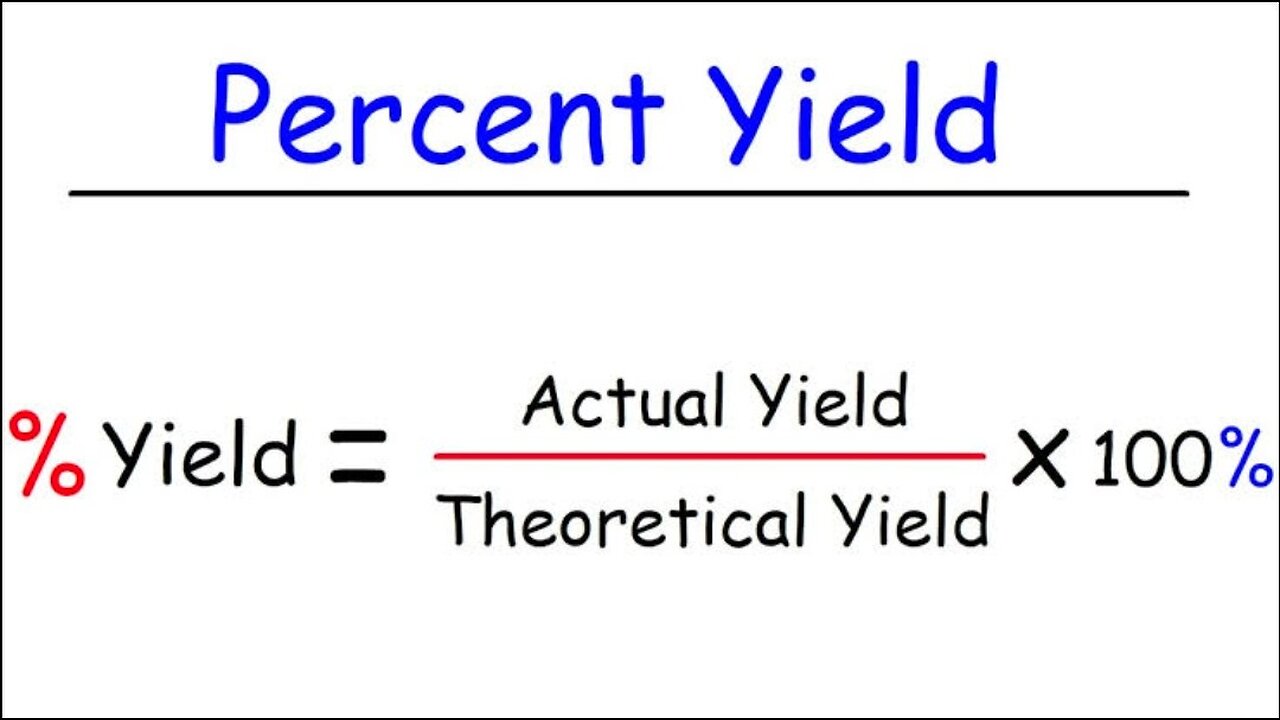Premium Only Content

How to find percentage yield| theoretical yield| Actual yield|2020|AIM Pharma
Percent Yield is defined as the actual yield divided by the theoretical yield times 100. Percent Yield=(Actual YieldTheoretical Yield)×100% There are many reasons why the actual yield of a chemical reaction may be less than the theoretical yield, and these will be taken up during later Chapters of the course.
Percent Yield
Percent Yield is defined as the actual yield divided by the theoretical yield times 100.
Percent Yield=(Actual YieldTheoretical Yield)×100%(4.3.1)
There are many reasons why the actual yield of a chemical reaction may be less than the theoretical yield, and these will be taken up during later Chapters of the course. Here are some reasons, most of which deal with topics that will be covered in the second semester of this course.
Equilibria between products and reactants, where the limiting reagent is not completely consumed (Chapter 15)
Ca3PO4(s)⇋3Ca+2+2PO−34(4.3.2)
Kinetics, simply speaking, the reaction may be very slow and not over (Chapter 14).
Formation of Intermediates. A chemical equation does not represent the mechanism but the overall balance of mass. The mechanism tells how the reaction actually proceeds (section 14.6), and there are often intermediate chemical species that are not completely consumed. This is exemplified in the following reaction.
H2(g)+2ICl(g)→I2(g)+2HClg(4.3.3)
It is highly unlikely that this reaction takes place in one step where three molecules simultaneously collide. A more plausible way for the reaction to occur is in two steps as below, where HI is an intermediate.
H2+IClHI+ICl→HCl+HI→HCl+I2(4.3.4)(4.3.5)
In the first step HCl and the intermediate HI are formed from the bimolecular collision of H2 and ICl. In the second step, the HI (intermediate) collides with another ICl to form HCl and I2. If you add the two steps the intermediate cancels out and you get the balanced equation.
H2(g)+2ICl(g)→I2(g)+2HClg(4.3.6)
4. Competing or Parallel Reactions
You may have a secondary reaction competing with the reaction described, like the formation of hydroiodic acid and chlorine gas.
H2+IClHCl+ICl→HI+HCl→HI+Cl2(4.3.7)(4.3.8)
So any HI or Cl2 formed would reduce the yield of the desired I2 and HCl. A parallel or competing reaction could also involve a completely different reactant. For example, if oxygen was available the following reaction could compete ICl for the H2.
2H2(g)+O2(g)→2H2O(g)(4.3.9)
AIM Pharma 2023
-
 23:05
23:05
Blackstone Griddles
16 hours agoEpisode 6 | Breakfast, Lunch, and Dinner
23.4K -
 1:12:00
1:12:00
The Car Guy Online
15 hours ago $2.55 earnedAutomakers EXPOSED, Whistleblowers SILENCED! NextGen Engineer Speaks Out!
24.8K11 -
 1:17
1:17
The Lou Holtz Show
16 hours agoThe Lou Holtz Show S2 EP16 | Hugh Freeze on Faith, Football & Restoring American Values #podcast
20.6K2 -
 2:01:21
2:01:21
BEK TV
1 day agoTrent Loos in the Morning - 8/22/2025
21.9K -
 4:01:40
4:01:40
The Bubba Army
1 day agoHogan's Death: Bubba Called it FIRST AGAIN! - Bubba the Love Sponge® Show | 8/22/25
55.5K5 -
 38:40
38:40
ZeeeMedia
19 hours agoMax Pace’s Crypto Revolution Story: Four Strategies to Win | Daily Pulse Ep 93
33.3K15 -
 2:16:46
2:16:46
"What Is Money?" Show
2 days agoBitcoin vs War, Violence, & Corruption w/ Gary Mahmoud
28.7K -
 28:33
28:33
DeVory Darkins
1 day ago $11.20 earnedNewsom suffers stunning EMBARRASSMENT as MAJOR retailer makes devastating announcement
36.2K75 -
 32:46
32:46
Coin Stories with Natalie Brunell
2 days agoInside Look at Strategy’s $70+ Billion Bitcoin Treasury
25.4K1 -
 8:21
8:21
MattMorseTV
19 hours ago $9.43 earnedTrump just SCORED a $500,000,000 LEGAL WIN.
122K47